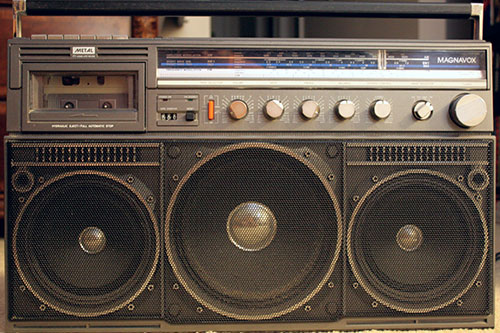Chartered Waters
Being gatekeepers, music charts have a massive influence on the songs we hear on the radio. And that influence isn't exclusive to Billboard, by the way.
1940

The researcher who was murdered, mob-hit style, after taking a stand for music-chart integrity
Of the many names that have been associated with Nashville's Music Row, Kevin Hughes doesn't have the star power of, say, Big and Rich.
But Hughes stood for something really important: With the small amount of power he had, he tried to make the music industry in Nashville a little less corrupt, and for that, he became something of a folk hero. Unfortunately, folk heroes rarely survive to the end of the story.
Hughes, a 23-year-old researcher for the Billboard competitor Cash Box, noticed something unusual with the magazine's independent country chart: Some of the artists were getting high placement on the charts despite never actually getting played on the radio or selling any records. Not willing to stand for payola practices, he pushed back against schemes to manipulate the chart, something that record promoter Chuck Dixon had long been accused of doing. Dixon was not the kind of guy you wanted on your bad side.
“He watched The Godfather—parts 1, 2 and 3—four or five times a week,” Gary Bradshaw, a colleague of Dixon’s, told Nashville Scene. “It was unreal.”
Bradshaw told the alt-weekly that the scheme worked like this: Dixon would get paid money by musicians to get on the charts, and he would use some of that money to wine-and-dine DJs, who would then take steps to promote whatever musician he wanted to get on the charts at the time. By taking advantage of the fact that both aspiring musicians and DJs were each essentially broke, Dixon made a ton of cash.
But when Hughes came along, he proved a threat to Dixon's scheme—and Dixon allegedly requested that a hit be taken out on Hughes. In the final days of his life, Hughes knew he was on thin ice.
"He was very concerned about something, you could tell by the tone in his voice, he was nervous, and almost scared," his brother Kyle told ABC News of the last time he talked to his brother. "At the end of the conversation he told me he loved me on the phone. And when he said that I knew something was wrong because we didn't talk about that on the phone."
An hour later, Hughes was dead, shot at point-blank range after leaving a studio with a friend, country singer Sammy Sadler. Sadler was shot in the shoulder, ran away, and survived.
"One minute, I'm getting into the car with a friend, and the next, a guy in a ski mask, wearing dark clothing approaches and opens fire," Sadler said in a 2003 comment on the case.
For more than a decade after the March 9, 1989 shooting, it was unclear who did it. This made Hughes' murder prime fodder for shows like Unsolved Mysteries, which did a segment about his death in 1990.
It took until 2002, three years after Dixon died, for a suspect to appear in the shooting—Tony D'Antonio, a former Cash Box editor, who was convicted and sentenced to life in prison the next year. Dixon never admitted any role in the shooting, but his death did help break open the case.
D'Antonio died in prison in 2014.
Stories like these severely hurt the reputation of Cash Box, a trade paper initially built around tracking trends in the jukebox industry, and it went under in 1996. It once had the reputation of Billboard, but lost that as the magazine gained its association with payola. In recent years, however, the magazine was revived as an online-only publication.
"I wanted to do something a little more unique. It looks good on college applications, but mostly I do it because it's fun for me."
— Matt Levine, an early newsletter author, explaining in a 1997 interview why he created a personal weekly chart of his top 50 alternative rock songs. Matt Levine's Top 50, which he started while just a teenager, was an early Usenet and email hit, and at one point led Levine to work on a music site called Alternative Rock World. Levine's chart, most issues of which can be found in this Yahoo group, went on for more than a decade, and exactly 600 issues, before he gave up on it in 2007.

(steviep187/Flickr)
The guy who spent his teen years trying to make modern rock radio suck less
These days, the modern rock charts couldn't be further from Matt Levine's mind. He has something more important to worry about—being a dad.
Levine, who lives in Edmonton these days, is a Canadian by marriage. But when he was a teenager, he lived in the Los Angeles area, within earshot of one of the most-influential rock radio stations in the country, KROQ.
There wasn't any grand plan behind his attempt to influence KROQ and other stations; he was just a bored teenager with a lot of extra time in 1995. ("I was 13, living in a Southern California suburb without any sort of public transportation. And it was too hot to go to the park and play basketball," Levine explained.)
He stumbled upon a site called Top Hits Online, later called BeyondRadio, and began submitting charts of his own. Eventually, he decided to launch his own website and newsletter. The favorable L.A. radio market gave his chart something of a natural advantage—before the MP3 era, he was able to catch songs on the radio dial before they broke nationally.
Levine built charts that mixed local radio airplay and his own tastes. Then, as now, alternative rock radio stations needed a little help understanding what was cool and what wasn't. And Levine's chart, which he sent to radio programmers around the country, was a way for programmers to understand what an actual teenager thought was worthy of a few extra plays—why, for example, an underdog band like The Flys or Matthew Good Band deserved notice, or why Hoobastank was (as he put it) "the second coming of REO Speedwagon."
"The charts weren't particularly scientific, but I aspired to have the songs have trajectories similar to Billboard charts," he explained. "The idea was that I could influence what rock radio stations would play around the country."
His chart won an audience at a time when Pitchfork was embryonic, Rolling Stone was already corporate, and publishers were still trying to make CD-ROM magazines a thing. As a result of that influence, he started to get interviews with a number of bands of the era—he specifically cites The Bloodhound Gang and Loud Lucy—and got into shows as a legit member of the media.
"Probably the biggest highlight was going backstage at the 1999 Warped tour, meeting and interviewing a bunch of bands I liked at the time. I don't have an Almost Famous kind of story to tell, but there were lots of cool little experiences that sprung from the chart," he said.
The chart even played a role in Matt's application to the University of California at Berkeley, where he once hosted a radio show, and his early work in online marketing. Eventually, though, he grew up, and as he moved into his 20s, he struggled to keep up the momentum on the chart that he breezed through in his teens. At the time when Issue 600 went up—three months late, by the way—he was plotting out a massive international trip with his then-girlfriend, whom he later married. And, after roughly 12 years of charting nearly everything he was listening to, that was that.
These days, he occasionally tries to keep up with the radio as well as what's buzzworthy, but he noted that the key driver of his playlists these days is the kids' music his daughter listens to. (She digs the Laurie Berkner Band's "I Know a Chicken" and Elizabeth Mitchell's rendition of "Froggie Went a Courtin'," in case you were curious.)
He looks positively on his experience as a teenage music-industry influencer, saying it made him a better writer, planner, and communicator.
"But directly, the chart hasn't factored at all in my ultimate career," he said. "But this may be due to where I've chosen to live. Los Angeles was an awful place to live in the '90s and I wanted nothing to do with it once I escaped."
Levine has a pretty good life these days—one far from machinations of KROQ or the pop charts.
"Contrary to current theories of musical evolution, then, we find no evidence for the progressive homogenization of music in the charts and little sign of diversity cycles within the 50 year time frame of our study. Instead, the evolution of chart diversity is dominated by historically unique events: the rise and fall of particular ways of making music."
— A section from The evolution of popular music: USA 1960–2010, a 2015 paper written by researchers at Queen Mary University of London and Imperial College London, disputing the idea that the Billboard charts are becoming more homogeneous, while arguing that the charges evolve in a cyclical nature. The paper discusses the way that drum machines took over during the '80s, the way the British Invasion simply took advantage of an already-shifting music market, and how rap basically killed rock music for nearly two decades. Long story short, it's an awesome paper.
Going back to Matt and his little-chart-that-could, I posed a question to him that I've been pondering for ages: Should we still care about charts? Do they even remotely matter anymore?
His take? Not really, at least in terms of these lists worth obsessing over like in the '90s.
"The best thing about Billboard in the 1990s was the use of Soundscan data to accurately determine which albums were selling," he told me. "But now that we live in an increasingly segmented streaming world, sales data matters only from an industry perspective. The money is now all in touring and endorsements—you record a new album to tour behind, rather than the other way around."
Billboard still has plenty of cultural cachet, as evidenced by its awards show, but I wonder if the magazine is simply running on reputation at this point. Levine, however, offers another idea: The influence of Billboard is best seen as osmotic—there will always be an audience for people who don't care very much about pop charts, and just want something to listen to.
"As a father, I don't have much time to dedicate to discovering new music," Levine said. "So Billboard, combined with a number of Canadian radio promoters, influence what I listen to."
For those of us who want to go off the grid, though, we're free to ignore the Hot 100 without consequence.
:format(jpeg)/2018/01/hhume9ykpxyhnafqemtq.gif)
/2018/01/hhume9ykpxyhnafqemtq.gif)

/uploads/ernie_crop.jpg)